
2017 has sure been a wild ride in the world of mobile internet!
The undeniable big story of the year is the return of "unlimited" cellular data plans, but the real limits lurking behind the scenes have never been more confusing.
But despite the confusing limits and loopholes - overall there has never been a better time for connectivity on the go.
Options abound, and with enough effort (and a bit of luck) it is now frequently possible to manage mobile connections that rival even the best home internet setups.
And despite some potential dark clouds on the horizon, 2018 promises to be just as exciting - with some major technological developments headed our way.
This is our annual end-of-year quick update on the state of the mobile internet world - chronicling some of the major changes that happened in 2017, and giving a glimpse at what we're most looking forward to in the year ahead.
Grab a comfy seat and get ready, this is a long one, chock full of information to bring you fully up to date on the current state of mobile internet.
Below you will find recaps of the major developments in Cellular, Wi-Fi & Routers, and Satellite Internet - the three primary internet options for staying connected on the go.
Don't miss any future news that impacts your ability to keep connected on the road!
- Sign up for our free monthly newsletter
- Add this feed to your RSS reader
- Join our free Mobile Internet Resource Center Facebook Page (for news posts only)
- Join our free Internet for RVers Facebook Group (for discussions)
- Members, can join our Private MIA Facebook group
- Sign up for our premium membership to support this site, and to get access to breaking news alerts, exclusive sneak previews of upcoming products, private member forums, interactive video chats, industry insider interviews, and lots more in-depth featured content! Our members make this site possible!
Note: This article assumes you have a basic understanding of the components of a mobile internet setup (cellular, Wi-Fi, satellite, signal enhancing, routers, etc). To get a primer on these basics, we recommend first reading through our free Overview of Mobile Internet Options guide.
This free article is brought to you by our premium members - who fund all of our work here at the Mobile Internet Resource Center! Thank you MIAs for your support all year long that allows us to keep super focused on this niche topic. We couldn't do this with you!!
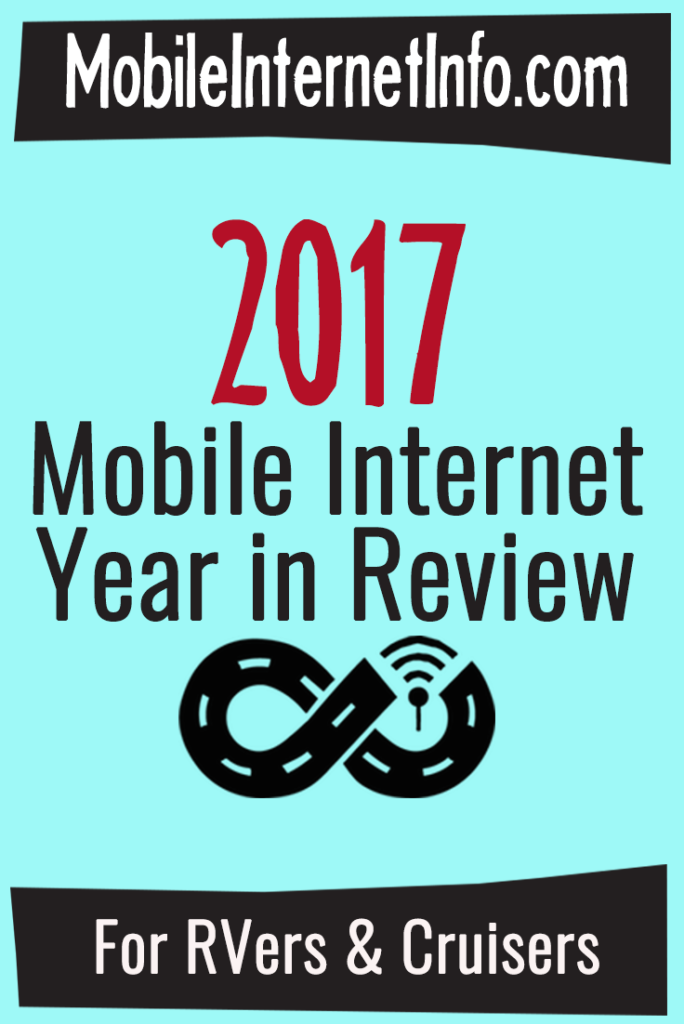 Table Of Contents:
Table Of Contents:
- Video Recap of Article
- Cellular Internet - 2017 in Review
- Wi-Fi & Routers - 2017 in Review
- Satellite Internet - 2017 in Review
- The Mobile Internet Resource Center - 2018 & Beyond!
Video Version
If you prefer, here's a quick 16 minute overview of this article:
(Like video? Be sure to subscribe to our YouTube Channel!)
Cellular Internet - 2017 in Review
 For most mobile users, cellular remains the fastest and easiest way to get online, and things have only gotten better in 2017 as coverage has continued to be expanded and unlimited plans have made a surprising resurgence.
For most mobile users, cellular remains the fastest and easiest way to get online, and things have only gotten better in 2017 as coverage has continued to be expanded and unlimited plans have made a surprising resurgence.
But the fine print lurking below the surface means that most "unlimited" plans actually have plenty of limits lurking.
Here are some of the bigger stories and trends from the year.
The Return of "Unlimited" Data!
Last January T-Mobile went "All In" with its T-Mobile One plan, completely dropping its metered-data Simple Choice plans to focus all of its efforts on promoting unlimited.
The more traditional tiered data plans still being marketed at the time by AT&T and Verizon looked increasingly awful in comparison, and in February the dam broke.
First Verizon, and then AT&T, jumped onto the unlimited data train in rapid succession.
It was the busiest week ever here at the Mobile Internet Resource Center as we tried to help explain the new definition of "unlimited" the carriers were trying to roll out, and which of these new plans most closely met the needs of mobile folks seeking home internet replacements.
Here is a quick recap of the changes from February - with links back to our in-depth stories for further details:
- Verizon Unlimited - Verizon's new plan not only brought back an official unlimited smartphone option to the nation's largest carrier, it also raised the stakes for everyone else by including 10GB (raised to 15GB later in the year) of high-speed mobile hotspot usage per line, and full HD video streaming. Unlike Verizon's fully unthrottled grandfathered unlimited data plans, these new plans are subject to both strict tethering limitations and "network management" that threatens to reduce speeds on congested towers after 22GB of usage. And to make matters more confusing, Verizon offered the ability to add one of their Jetpack mobile hotspot to their new plans for just $20/month - but the plans had the same high speed hotspot caps (that weren't initially clearly disclosed or enforced).
- T-Mobile One - Just hours after the Verizon news broke, T-Mobile CEO John Legere responded by announcing that T-Mobile One+ plans would now also include HD video streaming and 10GB of high-speed mobile hotspot usage. T-Mobile's network management threshold was raised to 28GB/mo (and eventually to 50GB/mo), and for $25/mo you can upgrade a line to "One+ International" to enable unlimited high-speed mobile hotspot usage from a phone. But T-Mobile offered no unlimited plans on dedicated hotspot devices.
- Sprint Unlimited - Two days later Sprint joined the fray, announcing that it would also now be including 10GB of high-speed mobile hotspot usage with Sprint unlimited smartphone plans, as well as unlimited HD video streaming. Sprint treats VPN usage the same as mobile hotspot data, limiting it to 10GB/mo. The carrier did not initially offer an unlimited options on dedicated data devices, but later in the year made a very limited "unlimited" hotspot plan available.
- AT&T Unlimited - The last carrier to respond was AT&T, wrapping up the week by announcing that the AT&T Unlimited plan that had formerly been available only to customers who also subscribed to DirecTV was now available to anyone. AT&T's initial offering was extremely underwhelming however, costing more than all the other carriers, and yet lacking in ANY mobile hotspot capability at all. AT&T's network management threshold was set at 22GB, the same as Verizon's. Just ten days later, AT&T tried again - roaring back with entirely new Unlimited Plus and Unlimited Choice plans that replaced the previously lackluster unlimited offering, including now the ability to add a dedicated data device with no mobile hotspot restrictions!
When the dust had settled, AT&T actually was left with perhaps the most attractive unlimited plans for heavy data users, an outcome that we never would have imagined just a month earlier.
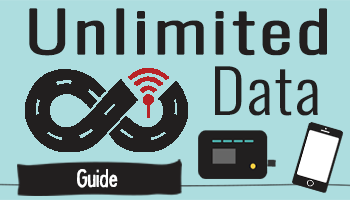
Our long time recommendation that Verizon was the best primary carrier for mobile travelers had firmly shifted to also now consider AT&T a top pick - based on the availability of such attractive data plans.
Further Reading:
For our overview guide & video explaining all these unlimited data plans options, and their less-than-obvious limits:
2017: The Year of the Mobley
Since 2015 most new Chevy, Buick, GMC, and Cadillac vehicles have come with "OnStar with 4G LTE" built in. This adds AT&T-powered Wi-Fi hotspot capability to the OnStar security and navigation features.
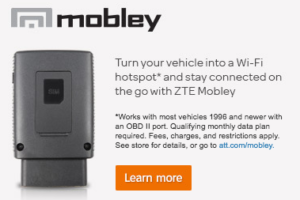
But with a special power supply, you can use a Mobley without needing it plugged into a compatible car.
The basic idea is to keep your passengers entertained and online while underway.
But the rather limited and expensive data plans meant that a backseat full of kids each streaming their favorite show could blow through a data plan FAST!
To address this concern, in March Chevy and AT&T began offering a new unlimited data plan for Chevys with LTE OnStar built in.
Now you could use as much data as you want, for just $20/month - with no other AT&T plan required!
In addition to modern Chevy vehicles, the AT&T Connected Car plan could also be activated on aftermarket Connected Car devices like the ZTE Mobley - a tiny cartridge designed to provide a Wi-Fi hotspot to nearly any vehicle.
And unlike the built in OnStar Wi-Fi that shuts down when the ignition is turned off, the Mobley can very easily be set up to run off a AC, DC, or USB power adapter - allowing 24/7 unlimited hotspot data on AT&T, for just $20/mo!
This made the "Mobley Plan" perhaps the best deal in the history of cellular, and the otherwise unremarkable Mobley sold out online as the word spread.
The plan is officially a Connected Device plan via the AT&T Connected Car department, however it popularly became known as 'the Mobley plan' - causing widespread confusion between the plan and the device.
By mid-September 2017 AT&T had "retired" the Connected Car plan for devices like the Mobley, though there were sporadic reports of successful activations up until early December. There have been no new $20/mo Mobley plans activated since.
Those lucky enough to grab a plan while they could have been grandfathered in with incredibly cheap AT&T data.
The Mobley device is frequently back in stock online. However it can now only officially be added to an existing AT&T Unlimited Plus/Choice plan, or to a capped 1GB or 5GB data plan. We still get excited reports from folks who think they scored the elusive Mobley device, only to be disappointed that the plan that made this rather basic cellular device attractive is no longer available.
For clarification, the Mobley device itself is not all that attractive - it has a basic cellular modem, lacks support for several AT&T LTE bands, doesn't support carrier aggregation, has no built in battery, needs a hacked power adapter, occasionally shuts down without warning, and has no official antenna ports. If you chose to go with an AT&T Unlimited Plus plan, do yourself a huge favor and get a more capable data device like that Netgear Nighthawk discussed below for just a $100 more. It's far more advanced and will deliver substantially better performance.
Read more about the saga of the Mobley in our regularly updated story:
Cellular Video Throttling (Almost) Everywhere
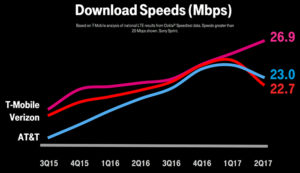
Nothing burns through data faster than streaming video - particularly HD video.
And with unlimited data plans available, customers have been streaming up a storm, bringing cellular networks to their knees in many places.
To fight back, every cellular carrier has moved to put some limits on their "unlimited" video streaming.
Here's how the major carriers have changed the video streaming game this past year:
- Verizon - Verizon made a big deal in February about not throttling video streams, but in August it changed its tune by embracing video streaming speed limits. The Verizon speed cap is set fast enough to allow 720p streaming on phones, and 1080p streaming on tablets and hotspots - and it is applied all Verizon plans, not just the new Beyond Unlimited data plan. If you want to stream 4K video without limits, in November Verizon began allowing customers to enable "Premium Streaming" without any throttle for an additional $10/mo.
- AT&T - All AT&T plans now enable a feature called "Stream Saver" by default that optimizes all video to low-res "DVD Quality". But, if you have an unlimited data plan you can easily turn this feature off - except on their budget minded and always-throttled AT&T Unlimited Choice plan.
- T-Mobile - T-Mobile's upgrade to HD video for all One customers did not last long, and currently the basic One plan throttles all video stream to 480p "DVD Quality". Upgrading a line to "One+" for $10/mo however unlocks full-speed HD video, and the $25/mo One+International upgrade allows for both unlimited HD and hotspot usage.
- Sprint - Sprint throttles all video streams to 1080p "Full HD" resolution, only limiting those who want to stream 4K video. Video streamed over Sprint's unlimited hotspot offering however is throttled down to 480p, making streaming to a smart TV a challenge.
We have a comprehensive guide to help you better take advantage of the streaming options out there:
LTE Technology Advancements
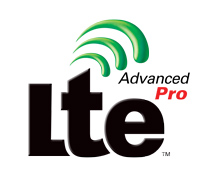
AT&T, Verizon, T-Mobile, and even Sprint have all been actively racing to deploy the various technologies that enable "Gigabit" LTE, the final step in the evolution of 4G/LTE before entirely new fifth generation (5G) technology arrives.
Our recent featured article profiles these technologies, and the challenges that lie ahead:
New Cellular Hotspots
Two particularly interesting flagship hotspots launched in 2017:
Verizon Jetpack MiFi 7730L by Novatel:
Announced in January, the MiFi 7730L hotspot is Verizon's first to support LTE Category 9, which allows combining up to three separate LTE bands to enable a max theoretical communication speed of 450Mbps.
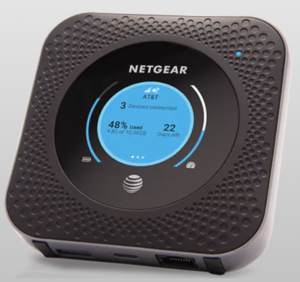
AT&T Netgear Nighthawk Mobile Hotspot:
In October AT&T released the Netgear Nighthawk - "the world’s first commercial Gigabit LTE Mobile Hotspot Router", capable of achieving theoretical peak gigabit LTE speeds.
The Nighthawk is a major jump beyond AT&T's current flagship Unite Explore mobile hotspot in raw LTE capability, but don't get too excited just yet: on AT&T's existing network you will only actually see a speed advantage in Austin and Cincinnati until AT&T's gigabit LTE deployments expand.
But if future-proofing is your goal, the Nighthawk looks to be the new king in AT&T town.
The 600MHz Auction: T-Mobile Wins Big
Wireless spectrum is like real estate - and there is only so much to go around.

When analog television was phased out for digital television in the United States in 2009, all the analog channels were shuffled to new digital homes. This freed up UHF TV channels 52-69 (698MHz - 806MHz) for cellular data use, a huge chunk of spectrum which the FCC auctioned off in 2008 ahead of the transition.
This low-band 700MHz spectrum reclaimed from UHF channels travels further and better penetrates buildings than higher frequency bands, making it extremely valuable for long-range cellular usage.
Verizon and AT&T dominated the 2008 auction, and this paved the way for those two carriers to claim a commanding lead in rolling out nationwide LTE cellular service in the years since.
But the demand for cellular data has been insatiable, and things were getting dire with no remaining low frequency spectrum left unclaimed for carriers to expand onto.
To help with the demand, in 2012 congress authorized the FCC to orchestrate another auction to free up more UHF capacity for cellular.
This time the owners of UHF TV channels would need to be persuaded to move channels, combine channels, or go off the air, so the FCC set up a fiendishly complex "incentive auction" where the stations would bid to establish their sale price to give up their spectrum, and the cellular carriers would then bid to control it.
After years of planning and a full year of multiple rounds of top secret bidding, the auction ended in April 2017 - and this time around T-Mobile was the big winner.
Here's the map showcasing the territory T-Mobile won, claiming at least 20MHz (two channels) in every single territory:
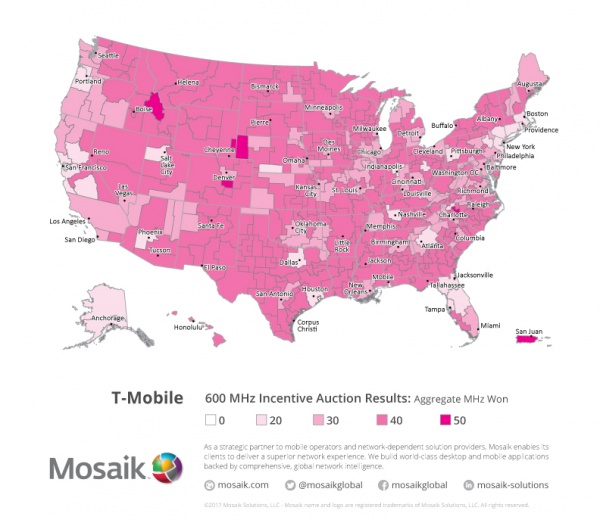
These new spectrum holdings will leave T-Mobile in an extremely competitive position versus even Verizon.
But keep in mind - it will take years to actually build out the network to take advantage of all this new spectrum.
Dish Network and Comcast also won major spectrum holdings in various parts of the country, paving the way for each of them to eventually roll out cellular service. Dish claims to be working on a 5G plan.
Read more about the auction results here:
T-Mobile's 600MHz LTE Band 71 Future

Some UHF TV stations are being allowed up to 39 months (over three years!) before they are required to relinquish the airwaves for 600MHz cellular service, but T-Mobile has been working to accelerate the process in many markets and has been fast-tracking the process substantially quicker than was thought possible.
But it is still going to take a long time for the towers to get built out, and especially for compatible mobile devices to get released.
As of the end of 2017, only the LG V30 and Samsung Galaxy S8 Active smartphones sold by T-Mobile are compatible with 600MHz LTE Band-71, though T-Mobile promises that many more models to be released in 2018 will be 600MHz ready.
600MHz is a big deal for T-Mobile, and anyone contemplating using T-Mobile should consider holding out for a 600MHz compatible device to ensure the best possible cellular coverage, or at least keep this fact in mind when purchasing T-Mobile equipment now.
To understand why low frequency spectrum is so important to long-range cellular coverage, read our featured members-only article:
Other Top Cellular Stories
Here are a few other memorable cellular stories from the past year:
AT&T Rural Plans
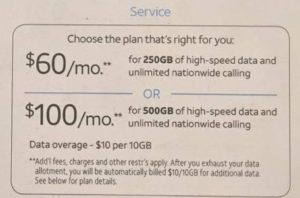
AT&T in February began offering the Wireless Home Phone & Internet "Rural Plan", upping the normal 25GB and 50GB data tiers to 250GB and 500GB for the same price.
The catch - you needed to have a billing address in one of the qualifying target areas, though once active the plans did support domestic travel - just always subject to network management when outside your designated zip code.
As this was prior to the Mobley and Unlimited Plus plans, this deal at first seemed unbelievable. And initially, AT&T's system allowed activations with any billing address if you found a rep who didn't know the official policy.
A lot of mobile households jumped on these plans during that window of opportunity, but the even better unlimited offerings soon made them mostly irrelevant. These plans do still remain available for those in the designated rural areas however.
 Verizon Cracks Down on Grandfathered Unlimited Data Plans
Verizon Cracks Down on Grandfathered Unlimited Data Plans
Unlimited data plans are not new to Verizon, they actually used to have a truly unlimited data plan and Verizon knows first hand how much data consumers can use if left without any limits.
With the advent of new unlimited data plans, fans of these plans have taken to referring to these older plans as 'Legacy' or 'Grandfathered' (gUDP for short).
Verizon caused a panic in July 2016 by sending letters to many out-of-contract grandfathered unlimited data plan customers that Verizon considered to be "excessive" data users, canceling their accounts. At the same time, Verizon cracked down on several unlimited rental line vendors who were egregiously violating Verizon's terms of service by reselling service.
Verizon then started off 2017 by making another similar move to crack down on heavy gUDP users in January, and all throughout 2017 there have been a continuous stream of reports of additional gUDP line rental vendors getting suddenly shut down leaving their customers in a lurch.
For the time being, gUDP lines are still obtainable. And those that have been kept under contract remain seemingly safe - but extending contracts has gotten much more difficult. We have a very active thread in our forums where members have been sharing their experiences with finding and protecting these coveted legacy UDP lines.
Sprint Offers FREE Unlimited Service To Switchers

Sprint's has been slipping into an increasingly distant fourth place in the US cellular market, but to try and hold on to some customers in June Sprint began offering customers with qualifying phones who transfer a line to Sprint a full year of FREE unlimited service.
This "limited time offer" has been repeatedly extended, and remains available as of December 2017.
We'd never recommend Sprint as a primary carrier, but if you are looking for a cheap backup line this is an interesting way to get one.
T-Mobile Introduces 'One Unlimited 55+'
In August T-Mobile began offering substantially discounted plans to those 55+, without cut back features. The only major T-Mobile feature this plan skimps on is by not including free Netflix service, but even if you subscribe to Netflix separately this remains a great deal for those who qualify.
AT&T Flirts With Cutting Off Unlimited Hotspots
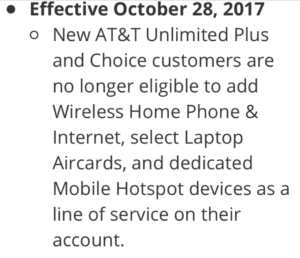
Even with the Connected Car "Mobley" plan retired, all year AT&T customers have been able to add unlimited data to hotspot lines on their multi-line account for as little as $20/mo (or activated as a stand alone plan without a smartphone for $90/month).
And unlike hotspot lines on Verizon (which are throttled to 600kbps after 15GB of high-speed usage), there are no arbitrary speed limits on AT&T.
This makes AT&T a great choice for those who truly need unlimited data on a hotspot, but there have been hints that this option may be going away.
In October AT&T even began notifying some customers that AT&T Mobile Hotspots were “No Longer Eligible” for Unlimited Data Plans, only to back away from that alert later.
We've heard rumors off and on that AT&T may once again move to shut down the sweet unlimited hotspot offering to new customers, so if this plan is on your radar - get grandfathered in while you can.
FMCA Begins Offering Cellular Plans to Members
 The biggest news story in June was the Family Motor Coach Association (FMCA) launching an amazing deal on Verizon with unlimited data hotspots. At just $43.99/mo for an unlimited hotspot data plan, this offering was more than an order of magnitude cheaper than anything you could get from Verizon directly.
The biggest news story in June was the Family Motor Coach Association (FMCA) launching an amazing deal on Verizon with unlimited data hotspots. At just $43.99/mo for an unlimited hotspot data plan, this offering was more than an order of magnitude cheaper than anything you could get from Verizon directly.
With a deal that good, the FMCA's intended soft-launch went viral, and the deal was soon being covered by major online news sites.
And before the FMCA could ship even a single hotspot, Verizon stepped in and pulled the plug.
But the offer details had already gone to print in the FMCA's next magazine issue - resulting in ongoing upset that turned into a very frustrating soap opera for everyone involved.
The FMCA tried again with a new "unlimited" Verizon hotspot plan launched in November, but this plan is actually in practice just a 25GB/mo plan - making it much less interesting than the earlier offer. But even so, $49.99/month for 25GB of high speed hotspot data on Verizon is a pretty attractive deal compared to a 30GB plan direct with the carrier at $205/month.
The FMCA also launched a Sprint unlimited plan for $49.99/month soon after.
This is only a handful of the stories we covered in 2017, so be sure to dive into the news center archives to read the other top stories for each of the major carriers: Verizon, AT&T, T-Mobile, and Sprint.
What are the current BEST Cellular Data Plans? Click for our quick summary:
Current Best Pick Data Plans for RVers for Each Carrier
[snippet slug = "cellular-data-plan-best-picks"]Cellular Boosters & Antennas
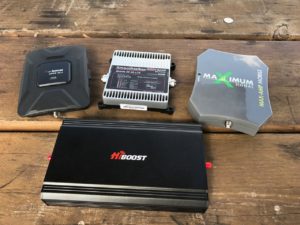
Cellular signal boosters remain useful tools to have in a mobile connectivity arsenal, but standalone antennas can often deliver even better performance for a fraction of the cost.
Here are some of our top stories from 2017 on the topic:
Smoothtalker Mobile RV X6 & HiBoost Travel 4G LTE:
We started off 2017 with the launch of the Smoothtalker Mobile RV X6 and the HiBoost Travel 4G LTE, two new models that we included in our early 2017 head-to-head testing rounds.
In April weBoost released a new official kit explicitly targeting the RV market based on our top-rated Drive 4G-X booster core. The Drive 4G-X RV kit keeps the proven 4G-X booster, and adds new interior and exterior antennas better suited to some types of RV installations. But do your homework - in our head-to-head testing, we determined the older Drive 4G-X OTR kit is very often a better choice, even for RV usage!
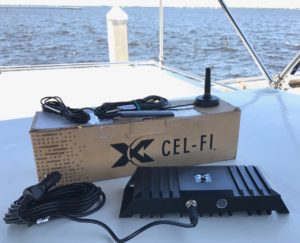
Cel-Fi Go M "Smart" Signal Booster:
We've been tracking Nextivity's unique Cel-Fi cellular boosters for years now - but up until this past year their technology has only been available in residential boosters that were a very poor match for mobile installations.
But in mid-2017 Cel-Fi brought to market the Go M, a mobile booster unlike anything we have tested before.
What makes Cel-Fi boosters different is that they are digital boosters that interact with a cellular network actively, rather than analog boosters like all the previous cellular boosters we have tested.
This technology theoretically opens the door for increased gain and indoor coverage, and the Cel-Fi Go M is allowed by the FCC to deliver 65dB of gain, well above the 50dB max legal limit of conventional mobile boosters.
There is a downside however. Because the Cel-Fi booster is working interactively with the carrier's network, it can only boost one carrier at a time. For example - if it is in Verizon mode, AT&T devices will not see any benefits at all.
We had some mixed results with our mid-2017 field testing, but unlike any other booster the Go M can get "smarter" via firmware updates. Cel-Fi listened to our feedback and implemented many fixes. We look forward to revisiting the Go M's performance in early 2018 in the next round of testing we're gearing up for.
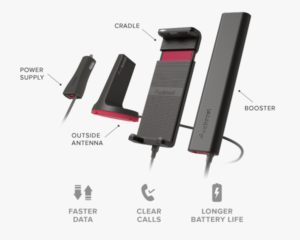
weBoost Drive Sleek Cradle-Stlye Booster:
In September weBoost launched a new cradle-style booster, the Drive Sleek.
A "cradle style" booster supports boosting the cellular signal for just one single device (held in the cradle) at a time - unlike full-size boosters that can provide both a more substantial signal boost, a wider indoor coverage area, and support for multiple devices being boosted at once.
This is what sets the Drive Sleek apart from its bigger brothers, the weBoost Drive 4G-M, and our reigning top pick - the Drive 4G-X.
But for many people, a full size mobile booster is overkill, particularly considering that a complete booster and antenna setup can cost as much as $500, versus under $200 for a cradle booster. This is an ideal form factor for those in a smaller rig or even for tow/toad vehicles.
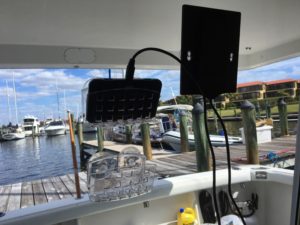
Netgear MIMO Antenna Blows Us Away:
The Netgear MIMO is a small directional portable antenna designed to attach via suction cup to a window - and it was the surprise hit of the year in our testing.
This affordable ($27.49!) antenna is for use with mobile hotspots with dual antenna ports.
When paired with a hotspot with external MIMO antenna support, this little antenna in many situations outperformed any booster!
Despite Netgear telling us they discontinued this particular antenna, it has remained in stock on Amazon these past couple of months. But there are several similar alternatives on the market, and we have purchased a few to begin longer term testing with.
Further Reading:
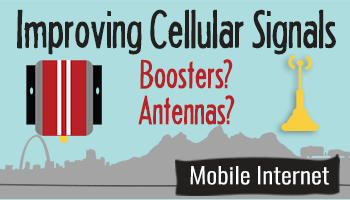 For our overview guide & video explaining cellular boosters and all the mobile options currently on the market, check out our featured free guide:
For our overview guide & video explaining cellular boosters and all the mobile options currently on the market, check out our featured free guide:
And to better understand and optimize your cellular connection, read our in depth member guide on the topic:
A Cellular Look Towards 2018...
Here are some of the big developments we are closely tracking into the new year.
5G Smoke And Mirrors
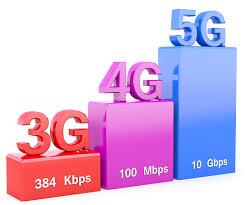 5G is coming, and it will be amazing.
5G is coming, and it will be amazing.
Eventually.
But 2018 is not the year that 5G will hit mobile users in any meaningful way.
Every cellular carrier and device manufacturer is right now working on their 5G plans, and throughout 2018 various demonstrations and market trials will make headlines as the kinks are worked out of what will be the next major disruptive shift in cellular technologies.
But even though AT&T has already taken to calling its latest 4G/LTE devices and upgraded markets "5G Evolution" compatible, this is all just marketing smoke and mirrors.
Real 5G mobile devices and widespread cellular networks are more likely to first hit in late 2019 or even 2020.
Until then - there is still plenty of life left in the latest gigabit LTE-Advanced tech, which is pushing existing LTE technologies to their limit.
The End of Network Neutrality?

As expected, in December the FCC voted to roll back the "Network Neutrality" rules that had first gone into effect in 2015 during the Obama administration.
With the FCC majority now under the control of the new Republican Chairman (and former Verizon lawyer) Ajit Pai - this rule change was considered inevitable despite record public opposition.
Rarely have FCC rules inspired such fire and passion. Just what is at stake with changing these rules on how internet providers are regulated?
Depending on which side of this contentious issue you listen to, this rule change represents the "beginning of the end of the internet as we know it" or overdue "action to restore internet freedom" by unleashing "investment, innovation, and competition" in the internet industry.
But behind the scenes it really comes down to control, and trust.
Who do you trust more to control and protect the open internet? Mega-corporations like Comcast, Verizon, and AT&T competing with each other? Or a federal bureaucracy setting rules that all providers have to abide by equally?
There are legitimate arguments to be made on both sides.
For an in-depth look at the issue, and the potential impacts (both positive and negative) on mobile internet users, read our in-depth article:
Network Neutrality - What Next?

The FCC's rule change legally goes into effect 60 days after the full text is published in the Federal Register, and that clock should start ticking any day now.
One interesting twist with the FCC's new ruling is that it forbids states from enacting any Network Neutrality rules of their own, and several state Attorney Generals have announced plans to file lawsuits objecting to the rule change, and especially the block on putting state-level rules in place.
Meanwhile - there are some representatives and senators from both parties in Congress that hope to tackle the Network Neutrality issue via law rather than via FCC rule making.
No matter what side of the issue you are personally on, the fight over network neutrality is not over yet.
We'll be tracking the FCC closely to keep an eye on how all the upcoming changes in policy will end up impacting all of us who rely on cellular data connectivity.
Cellular, Cable, and Media Companies Keep Cozying Up

Remember the days of bundled service - where your cable company would provide TV, home phone, and internet service?
Those days are very likely coming back - only this time cellular devices will be the center of it all.
AT&T already owns DirecTV and is moving to buy Time Warner (parent company of CNN, TNT, HBO, and Warner Brothers) - which would turn AT&T into a media giant. Meanwhile, AT&T seems intent to do everything possible to encourage AT&T customers to also subscribe to DirecTV - and AT&T is now even offering free HBO to most customers.
Verizon has acquired AOL and Yahoo - and is aiming to rival Google in being able to deliver targeted advertising based on deep customer tracking. Many expect that this is only the beginning of Verizon's corporate buying spree. Rumors remain of Verizon potentially hooking up with a major cable company.
T-Mobile has announced plans to acquire media streaming company Level3, and to "bring real choice to TV" the same way T-Mobile revolutionized cellular - with details to be revealed later in 2018. And T-Mobile has also partnered with Netflix, offering T-Mobile family plan customers a free Netflix subscription.
And Sprint Unlimited Freedom Plans now come bundled with a free Hulu subscription.
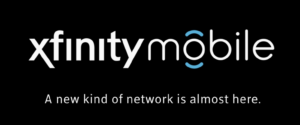
Meanwhile, cable TV giant Comcast has gotten into the cellular market by launching Xfinity Mobile, and Charter will be following suite in 2018 with a cellular bundle of its own.
Tthough details remain scant, Dish Network has been buying up spectrum and has indicated plans to deploy a 5G cellular network at some point down the road too.
The line between cable companies, satellite TV companies, home internet companies, media companies, and cellular companies seems destined to keep getting blurrier and blurrier in 2018.
We noticed this trend last year, and said at the time:
If competition heats up, it might bring about a price war that is good for consumers - particularly if you are willing to buy into bundles of services from a single provider.
But there is also a potential dark side to massive industry consolidation, and to bundles that take away choice and diminish competition. With network neutrality rules going away - carriers may even make it prohibitively expensive to access unlimited HD video outside of an officially sanctioned bundle deal.
We'll have to wait and see how it all plays out - but the year ahead certainly looks destined to be interesting!
Wi-Fi & Routers - 2017 in Review
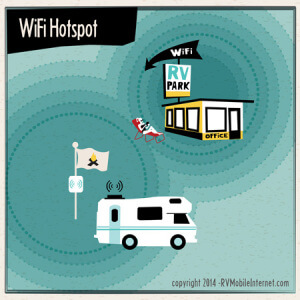 With unlimited cellular plans easier to come by, interest in long-range Wi-Fi has been decreasing throughout 2017.
With unlimited cellular plans easier to come by, interest in long-range Wi-Fi has been decreasing throughout 2017.
Meanwhile some campgrounds are finally investing in usable Wi-Fi networks for their patrons and many entrepreneurs are gearing up to offer a variety of new RV-focused Wi-Fi solutions.
But even if reaching out to access a distant Wi-Fi network has become less of a goal, mobile-friendly routers still play an important role as the hub of many mobile network setups.
Some of the most interesting product announcements of 2017 were focused on combining cellular and Wi-Fi into a single integrated device
Here are some of the products and news stories that most intrigued us in 2017:
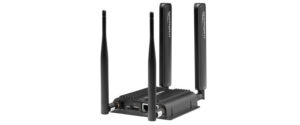
In early 2017 mobile router manufacturer Cradlepoint released a new flagship COR IBR900 router with an integrated LTE-Advanced cellular modem.
The COR IBR900 has gone on to earn a solid reputations with those looking to have just about everything integrated into a single (expensive) industrial-grade device.
In March mobile router manufacturer Peplink caught up with Cradlepoint by upgrading most of its cellular-integrated routers to also support LTE-Advanced modems, but the next-generation MK2 update for the popular MAX BR1 model did not actually come out until late November.
This update however packs in a lot of great features - including gigabit ethernet ports and 802.11ac Wi-Fi, making for a major step up from the old model.
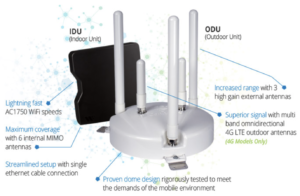
In October 2016 when we wrote about the new Winegard ConnecT roof-mounted long-range Wi-Fi receiver, there was something that we were asked not to share - our test unit was also equipped with cellular capabilities.
Winegard was at last ready to go public with its LTE offering in April 2017 - though the pricey data plans offered with the ConnecT 4G1 were just one of the downsides of this awkward-looking package.
WiFiRanger SkyPro LTE Announced, and Delayed:
Long-time RVer favorite WiFiRanger in April also announced a cellular-integrated model, the roof-mounted SkyPro LTE.
But in response to feedback from numerous beta testers (including us), WiFiRanger has told us that they have put the SkyPro LTE model on hold until 2018.
RV accessory manufacturer Magnadyne announced a new Mobile Vision MV100 roof-mounted Wi-Fi range extending system in November, similar in some ways to the WiFiRanger Sky Pro pack - but substantially cheaper (and seemingly a lot more limited).
One interesting twist - you can get the Magnadyne system combined with an integrated TV/FM/AM antenna - all in one unit.
We'll be starting our 2018 off by putting the Cradlepoint COR IBR900 and the Peplink MAX BR1 MK2 into extended head-to-head testing, and will provide in-depth reviews and analysis for our members about how these two high-end cellular-integrated routers compare.
This will add to the extensive testing we did on the latest crop of mobile routers and Wi-Fi extending gear we tested in 2017 that our in-depth reviews are based on - including products from WiFiRanger, Pepwave (SOTG & SOHO), Alfa, Winegard and more.
For more information on mobile routers and how they can play a role in an RV - as well as the options available - check out our in-depth featured guide:
Mobile Routers & Wi-Fi Look Towards 2018
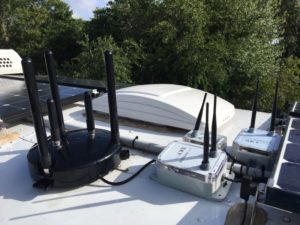
The trend towards cellular modems integrated with Wi-Fi routers looks likely to continue in 2018 - and we are especially intrigued to see more roof-mounted solutions that integrate in both Wi-Fi and cellular antennas into a complete package.
Here's some of what we expect to see in the year ahead:
Winegard ConnecT 2.0: We were extremely underwhelmed by the Winegard ConnecT 4G1 - finding it lacking for both Wi-Fi range extension and for cellular access. (Read our review)
The original ConnecT was expensive, the cellular version was tied to a very limited and pricey data plan, and the physical unit was an ungainly beast that looked like an ugly inverted stool on your RV roof - seemingly destined for a disastrous encounter with a tree branch.
Winegard must have been paying attention, because at the recent RV Dealers Association International Expo in Las Vegas Winegard announced a completely redesigned ConnecT 2.0 that will be coming to market sometime in early 2018.
Though details remain scarce, the ConnecT 2.0 will be vastly cheaper, no longer locked in to a single data plan, and the external antennas will all now be contained within a much sleeker plastic dome housing.
SkyPro LTE (Again): WiFiRanger has also been working on a better cellular integrated roof-mounted system, and they've told us that they are holding back the SkyPro LTE until they can integrate a modem that is fully carrier independent.
Forcing people to pick between AT&T, T-Mobile, and Verizon was just too limiting, and RVers are very reluctant to get locked in.
We have hopes that the next SkyPro LTE model will be able to deliver a great cellular experience, without sacrificing the leading long-range Wi-Fi performance that WiFiRanger is known for.
What About WiFiRanger Passport?
This time last year WiFiRanger announced an upcoming initiative called "Passport" with the ambitious goal of making fast campground Wi-Fi a lot easier to find and take advantage of.
Passport was supposed to start showing up in RV parks throughout 2017, but as the year rolls to a close WiFiRanger reports to us that development of the Passport system has proven to be a lot harder than anticipated - though work continues.
Perhaps this ambitious project will bear fruit in 2018.
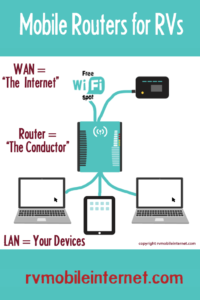 More "Solution Providers" Coming
More "Solution Providers" Coming
We are also tracking a few companies that aim to provide "complete solutions" for mobile users - providing packages of hardware, cellular plans, antennas, various special remote monitoring features, and "concierge level" support to manage it all for your remotely.
This model is nothing new - we've look at MaxxFi in the past, and we've had several members purchase packages from SinglePoint as well.
More recently we've heard from Konnected Technology and WiFiMyLife - and we know of others out there with similar bundles in the works.
While most of these companies are selling rebranded off-the-shelf hardware (usually Cradlepoint, Peplink, or MoFi) combined with support - is there enough of a market to build this many sustainable businesses around this model?
We'll be researching these options more closely in 2018, and will share our analysis first with our members.
The Dream: Long-Range Wi-Fi & Gigabit LTE Combined?
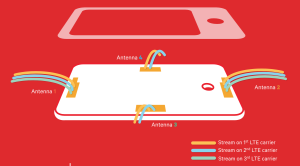
Cellular technology is advancing at a tremendous rate - but Gigabit LTE requires 4x4 MIMO to function at maximum speed.
And this means four cellular antennas.
We'd love to see a gigabit-class roof-mounted cellular router with four antennas capable of delivering gigabit performance via both cellular and 802.11ac Wi-Fi- but sadly do not expect such a product in 2018.
Only the very latest flagship smartphones have integrated gigabit LTE capabilities, and only one consumer hotspot (the Netgear Nighthawk) has been released with 4x4 MIMO support.
The discrete modem modules necessary to build a low-volume roof unit typically lag the consumer hotspot market by a year or more.
Perhaps in 2019 we'll see Gigabit LTE technology combined with a roof-mounted long-range Wi-Fi router. Maybe.
But we'd love to be wrong, and to see something sooner!
Satellite Internet - 2017 in Review
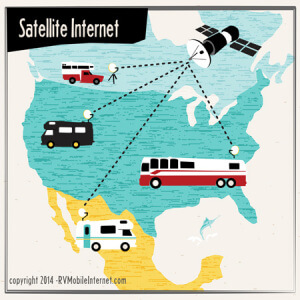 It has been an exciting year for space fans, and satellite internet has become a more viable option than it has been in years.
It has been an exciting year for space fans, and satellite internet has become a more viable option than it has been in years.
Here are the top satellite stories of the year:
Iridium Next Takes Off
SpaceX Launches First Wave of the Iridium Next Satellite Constellation Into Orbit - The year began with the first launch of the massive Iridium Next satellite constellation upgrade project, and three additional launches (of 10 satellites each) have continued throughout 2017.
The current Iridium constellation was launched between 1997 and 2002, and is best known for enabling satellite telephones that work anywhere on the globe. But despite the unrivaled global coverage, the Iridium system was only ever capable of providing extremely slow and very expensive data connections.
The new generation of Iridium Next satellites are more data-centric, and once the constellation is fully upgraded it will enable a whole new range of services.
HughesNet Gen5
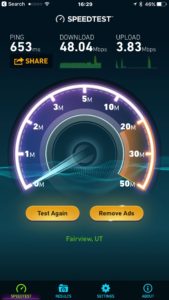
In April HughesNet began rolling out its 5th generation service - and it is (for now) a massive step up from the poorly regarded HughesNet of of the past.
If you want a satellite internet option available today, the new HughesNet Gen5 system is proving itself with several RVers now reporting great experiences with mobile-enabled Gen5 service.
Do keep in mind - HughesNet primarily intends their service to be professionally configured fixed residential installations, and if you do have normal HughesNet Gen5 service it will NOT connect to the satellite if you take it more than 50-100 miles away from your provisioned home spot-beam service area - no matter how much time you spend aiming the dish.
But truly mobile Gen5 service IS possible - if you work with a reseller that is set up to offer it.
The expert in this for the RV market is MobileInternetSatellite.com - they specialize in providing the tripod-based portable systems and the special mobile provisioned plans, as well as the training in manually aiming and configuring your system at each location you stop at.
ViaSat-2 Launches
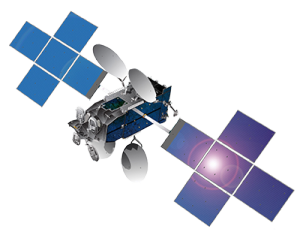
In June, ViaSat successfully launched ViaSat-2, a second generation "super satellite" with more than twice the overall system capacity of ViaSat-1.
This makes ViaSat-2 the "world’s highest capacity communications satellite", and opens the door to a completely revamped next generation Exede service.
ViaSat-2 has been slowly rising to its final geostationary orbital position, and new services taking advantage of the satellite are expected to launch in 2018.
The ViaSat blog says "patience, grasshopper" in response to questions about plan pricing, speeds, and data limits.
But even with new mobile-friendly options coming to market, satellite internet still remains primarily an option for those who have no other options.
If there is decent cellular coverage where you need to get connected, odds are cellular will continue to be a better choice - at least for the next few years.
- Satellite Internet Options for RVers - Our featured guide on all the current and future satellite internet options of interest to RVers.
- Satellite Internet Update: Iridium, OneWeb, SpaceX, and HughesNet - Our mid-2017 look at the state of satellite internet.
Satellite Look Towards 2018 (And Beyond)
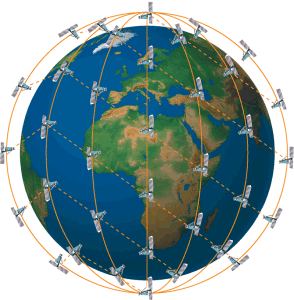
With technology advancing and the costs of launching a satellite into orbit plunging, things are only going to get more interesting on the satellite front.
Kymeta Satellite Antennas:
The challenge with satellites is that they are so far away, and particularly with mobile installations, require bulky parabolic dishes with which the precise aiming required can be prohibitive.
Advanced next generation antenna technology promises to allow a flat satellite antenna to be digitally aimed with no moving parts, even working while in motion.
We've been tracking Kymeta's work to commercialize this technology, and they have even done a trial deployment in partnership with the Hymer RV company.
The Kymeta antenna still has a long way to go before it is practical and affordable for those with less than military or industrial-sized budgets, but we expect to see some progress in 2018 towards Kymeta becoming something worth considering.
Iridium Next:
Iridium has now successfully completed four of the eight launches required to fully replace and upgrade the 66 satellite Iridium constellation - and sometime in 2018 new Iridium Next powered services will be ready to come to market.
The Iridium NEXT system will offer "speeds from 22 kbps and eventually all the way up to 1.4 Mbps once fully deployed" - painfully slow by LTE cellular standards, but much faster than what is possible with the current generation of affordable global coverage Iridium technology.
ViaSat:

Now that ViaSat-2 is in orbit, new services based on the new capabilities are slated to be launched in 2018.
Meanwhile, progress on the massive ViaSat-3 satellites continues - and the first (of a planned three) is slated to launch in 2019 or 2020.
When the third ViaSat-3 satellite goes online (scheduled for 2021), ViaSat is hoping to become "the world’s first global broadband service provider" with the capability to deliver amazing speeds all around the world - bringing "affordable satellite Wi-Fi connectivity to billions of unconnected people in emerging markets".
We spoke with Keven Lippert, EVP, Satellite Systems & Corporate Development - and he told us that RVers (and RV parks) were definitely on ViaSat's long-term radar.
"ViaSat-1 was aimed at residential and inflight. As we expand our network with ViaSat-2 & 3 it lets us explore other options. Mobility will be a big part of that."
We are eager to see whether ViaSat's massive geostationary satellites will be able to compete effectively with smaller and cheaper low-earth-orbit swarms.
OneWeb:
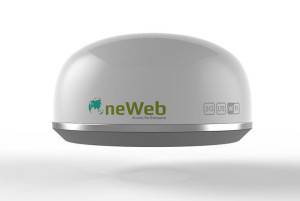
Meanwhile - OneWeb has received FCC approval this year to move forward with (literally) launching its upcoming network, which will eventually consist of a 700 satellite swarm.
OneWeb claims it will be able to support 50Mbs speeds, and 30ms latency - a huge improvement over the 600ms latencies common with geosynchronous satellite systems.
If all goes according to plan, the first in a long series of launches will begin in 2018, and in 2019 commercial service may launch in many areas of Alaska and Canada, providing access to low-latency broadband speeds for the first time ever.
Once the remainder of the swarm launches and comes online, OneWeb will be able to start offering services at lower latitudes too.
SpaceX:

In addition to providing launch services to Iridium, SpaceX has also been working on a massive satellite communications network of its own - first announced in 2015, and detailed in FCC filings in November 2016.
SpaceX revealed plans for an 800 satellite preliminary swarm that would then be fleshed out to 1,600 satellites for the initial deployment phase.
The next phase of the ramp-up would add an additional 2,825 satellites - bringing a total of 4,425 operational satellites online to enable high bandwidth (up to 1Gbps!) and low latency (25ms claimed) service anywhere on earth.
It sounds amazing - particularly when you consider that there are currently estimated to be only 1,459 operational satellites in orbit.
In a more recent FCC filing in March, SpaceX revealed that it intends to launch an additional very-low-earth-orbit (VLEO) constellation consisting of 7,518 (!!!) satellites orbiting just 210 miles above the surface to bring online additional network capacity.
It sounds like an insane plan, but SpaceX makes its ambitions clear:
"These assets, referred to herein as the “VLEO Constellation,” would enhance capacity where it may be needed most, enabling the provision of high speed, high bandwidth, low latency broadband services that are truly competitive with terrestrial alternatives."
Amazing! But when?
SpaceX hopes to launch prototype test satellites in 2018, and if all goes well the operational launch campaign would begin in 2019 and will run in phases through 2024.

The Mobile Internet Resource Center: 2018 & Beyond!

2017 has been a big year for us personally, as well as here at the Mobile Internet Resource Center.
Those of you who follow our personal blog over at Technomadia.com have witnessed our adventures as we've switched from full-time RVing to dividing our time between our RV and our new home on the water - a Bayliner 4788 motor yacht.
Our plan is to spend the next few years cruising the Great Loop which is all intercostal and inland waterways in North America. It's kind of like 'RVing on water'. We'll be spending our summers on the water and our winters on the road.
Along with our personal integration of boating, astute readers might have noticed that the RV Mobile Internet Resource Center has gradually been shifting to become simply the Mobile Internet Resource Center as we begin to incorporate some content focused on marine applications in addition to the RV market.
This broadening of focus will continue, but have no fear - our RV-focused content will remain unrivaled and a high priority for us (we are still RVers after all).
Also new this year, we launched a dedicated YouTube Channel for The Mobile Internet Resource Center. Subscribe there to get video guides and news stories on all things mobile internet.
Another big addition to the Mobile Internet Resource Center in 2017 has been the debut of our Mobile Internet University - a newly organized classroom that steps our members through our written & video guides to ramp them up from assessing their needs to understanding the options and selecting their personal arsenal.
You can get a free preview of the first section.
A New Handbook?
 The 2016 edition of The Mobile Internet Handbook has been out for nearly two years now, and the world of mobile internet has changed a LOT since we last put together a comprehensive offline guide.
The 2016 edition of The Mobile Internet Handbook has been out for nearly two years now, and the world of mobile internet has changed a LOT since we last put together a comprehensive offline guide.
In fact - things change so fast that it really doesn't make sense to try and keep a traditional book up to date.
Instead of a fully updated 240+ page printed book. we are instead now working on a slimmer and simpler guide focused on the basics - going back to the true "handbook" concept we originally launched in 2013. It will likely be just over a 100 pages long.
This new edition of the Mobile Internet Handbook will be released in early 2018 (we're aiming for late January).
But just because we are slimming down the book, doesn't mean we are scaling back our in-depth content. In fact, it is just the opposite!
Instead of writing chapters in a printed book that are difficult to keep updated, we are now moving our most in-depth content into online guides that we will be able to regularly revise as the industry continues to shift.
Here are a few of the former book chapters that have become in-depth guides that are already online (some portions are member-exclusive):
[snippet slug = "featured-guides"]Our staff is busily working to move chapters we are trimming out of the book over to new guides, including: Mobile Internet Security, Privacy and VPNs, Strategies for Backups on Mobile Internet and A Lesson in Cellular Evolution
And of course, our premium members will continue to receive free updates to everything we release - including the book and new guides.
Want to be notified when the new book is released? Join our E-mail List
Thank You Members

There is no way we could track this industry all year long and bring a resource like this together without funding. Instead of seeking sponsorships and advertising, we choose to be community funded and remain accountable to our readers.
Content like this extensive year end guide is brought to you by the generosity of our MIAs - our premium members. For their support, they get a bunch of extra perks like in-depth guides, reviews, Q&A forums, the classroom, webinars and more.
We research the options, share our personal & professional experience, and analyze industry news... so you can focus on what drives you.
It is our honor to be able to bring this site to you, and a true joy to assist our members further.
Thank you for making it possible!
Learn More About Joining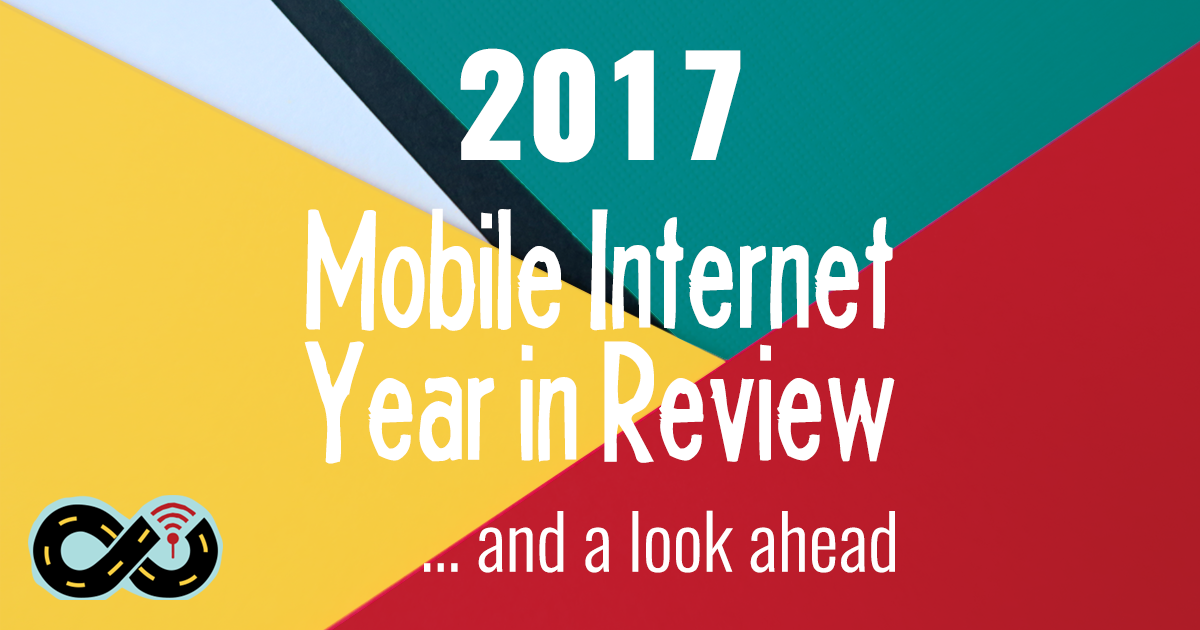
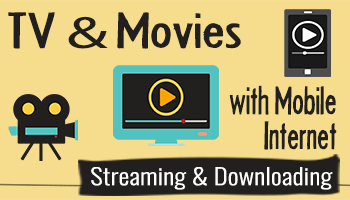
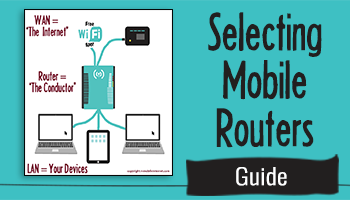
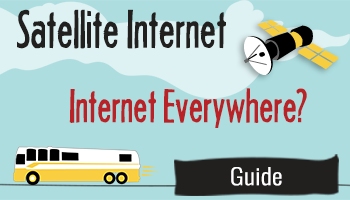


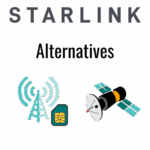





 Mobile Internet Resource Center (dba Two Steps Beyond LLC) is founded by Chris & Cherie of
Mobile Internet Resource Center (dba Two Steps Beyond LLC) is founded by Chris & Cherie of